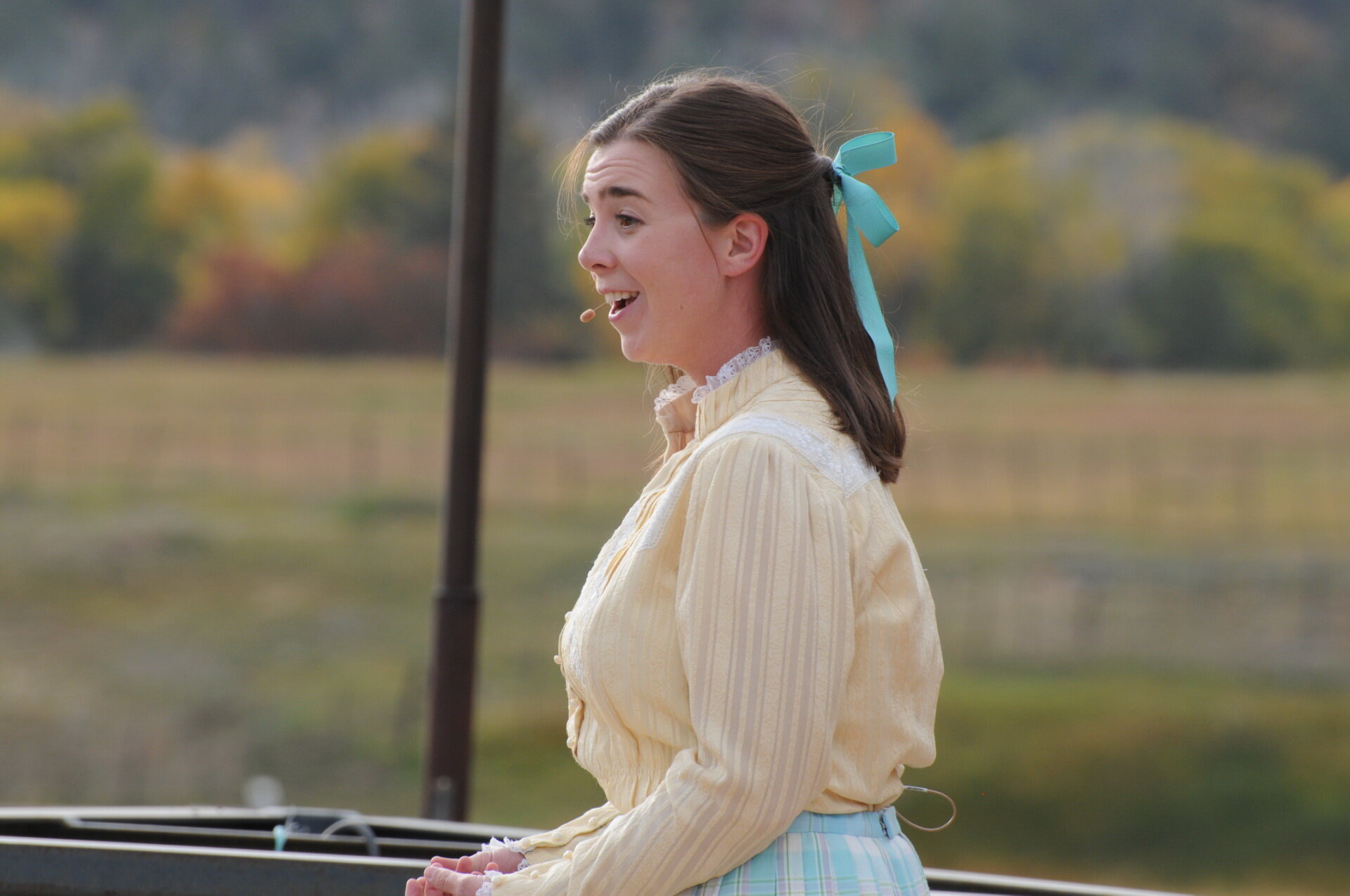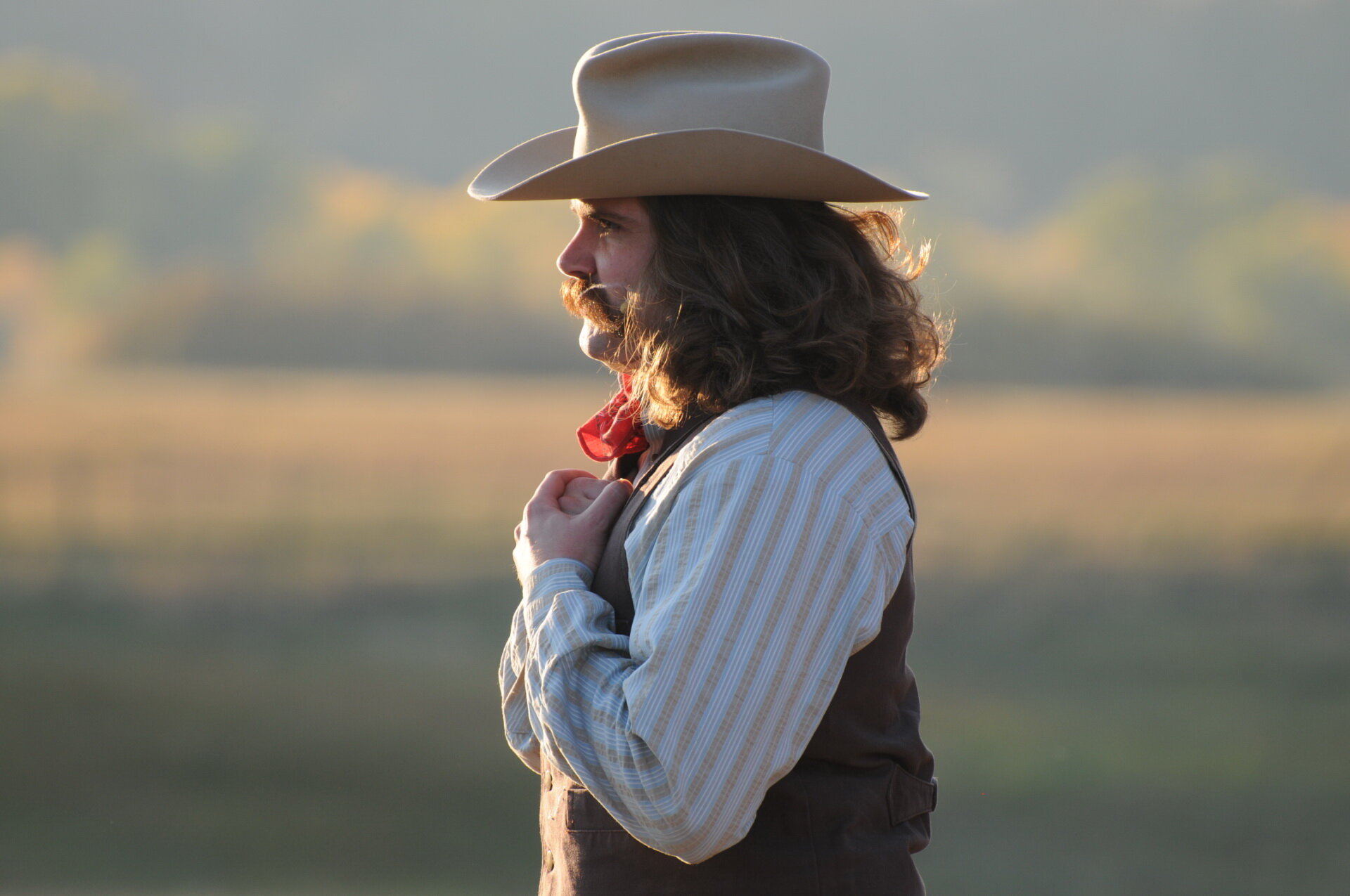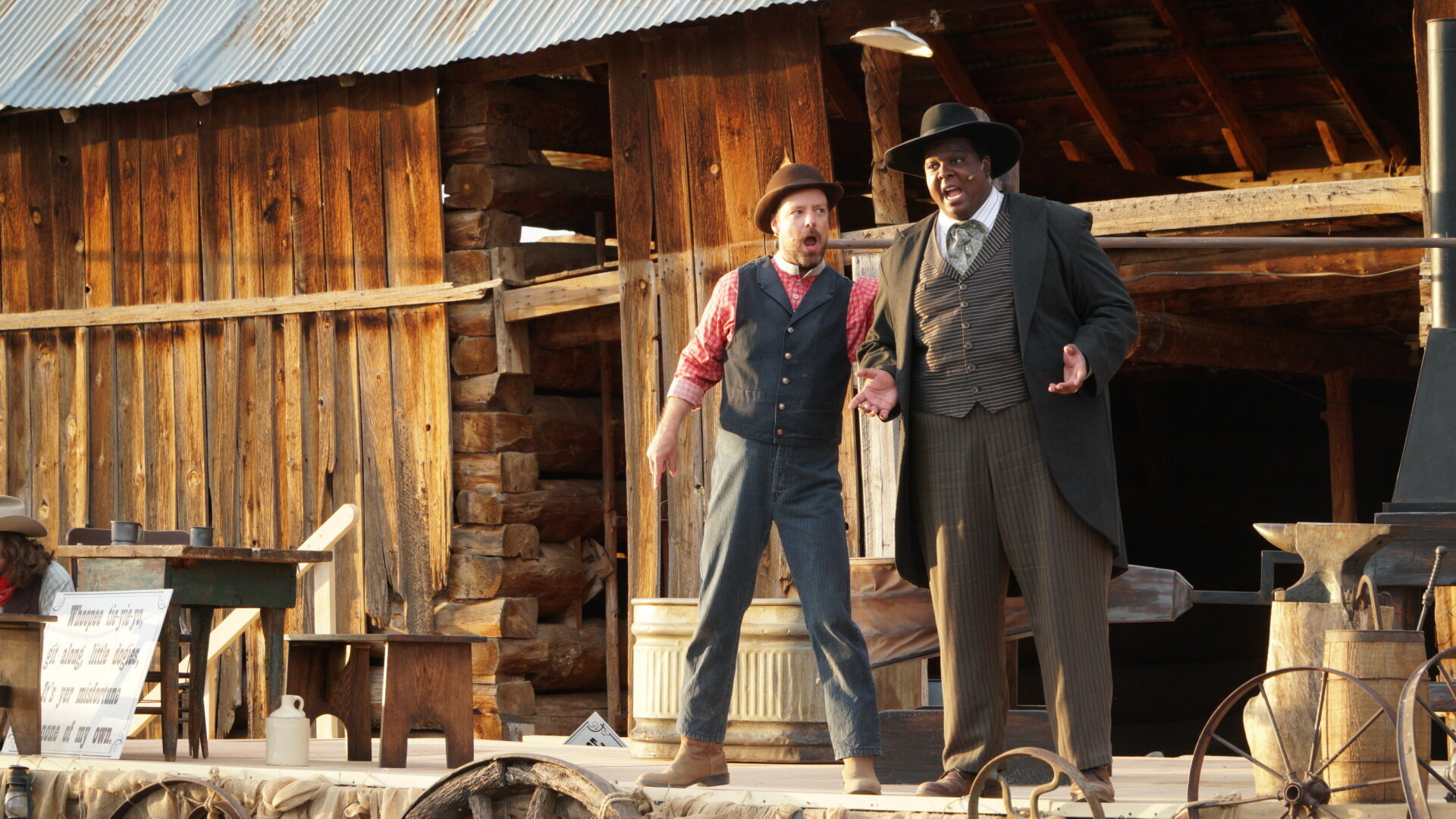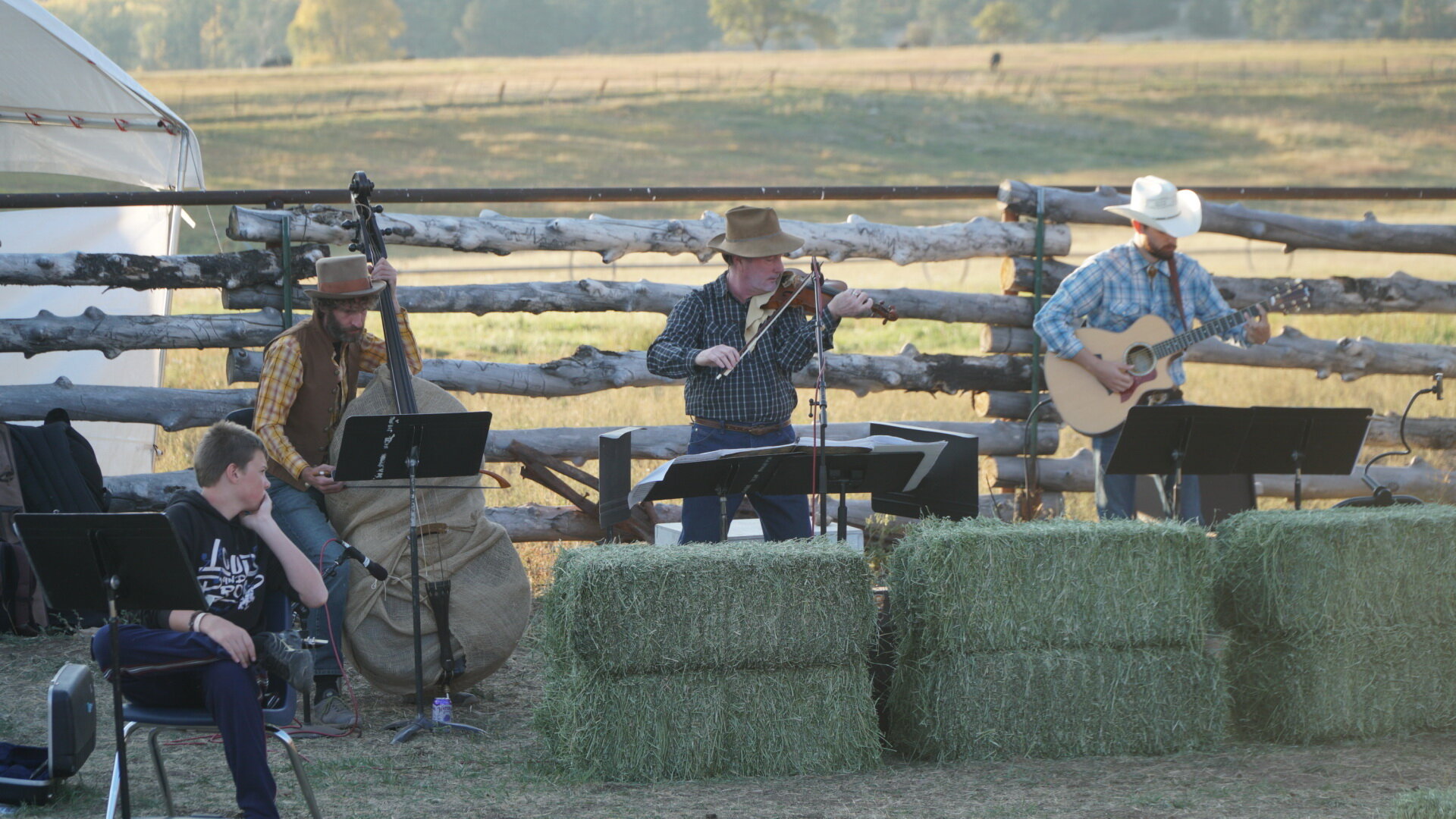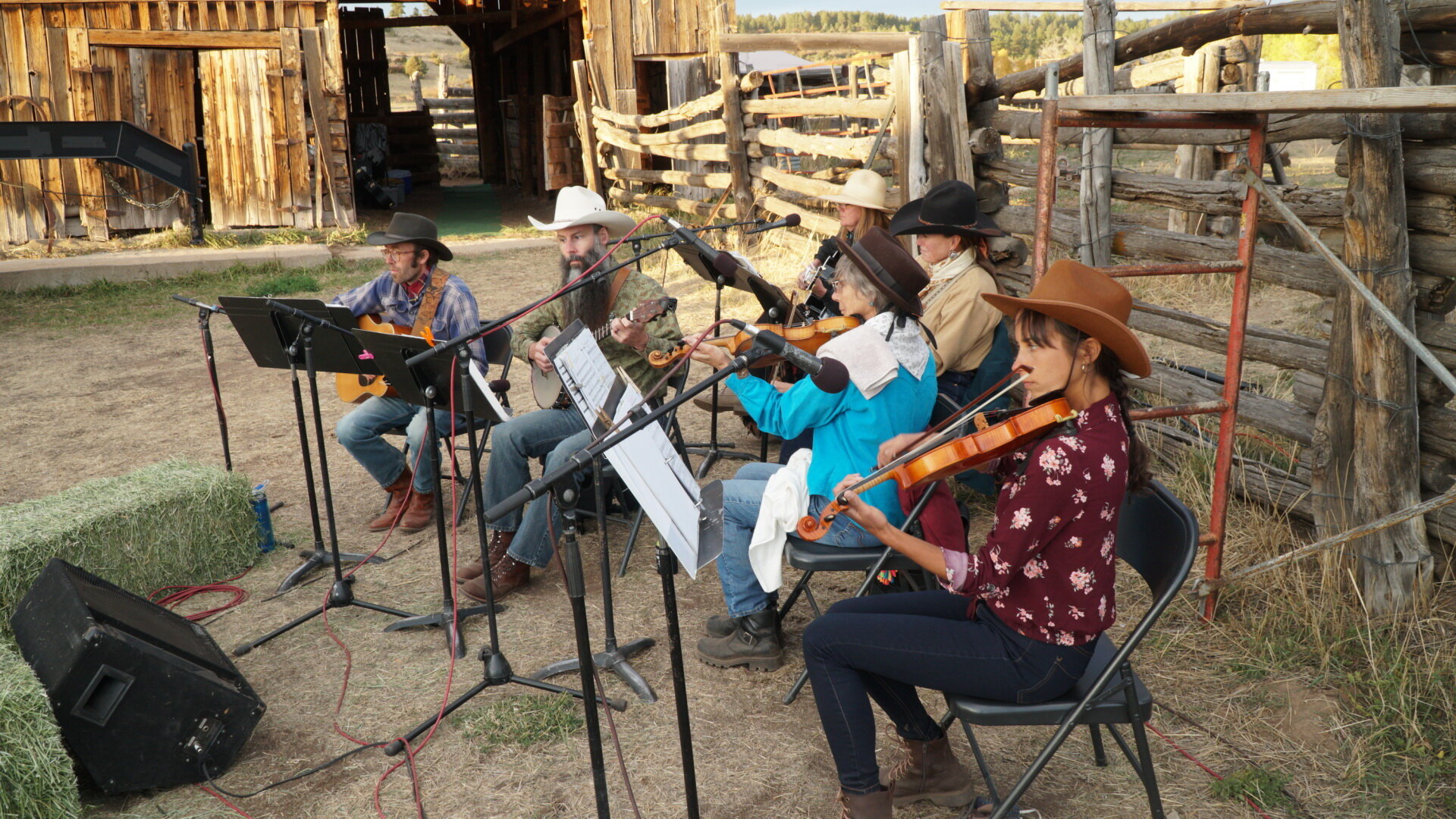Opera Lafayette’s The Blacksmith is adapted from a French opéra comique, Le Maréchal ferrant, written in 1761. I will have to take Artistic Director Ryan Brown’s word for that. OL’s version takes place in 1890s Colorado; the libretto has been translated into “cowboy English”, and the music has been adapted for an orchestra consisting of a violin, a contrabass, and a guitar, plus local musicians who join in on American folksongs that replace the French ones. Okay, the blacksmith character is portrayed as a French immigrant, but other than that, it is a far piece from Mancos, Colorado to seventeenth century Paris. Viewing the film, I had the feeling I was transported back in time to watching a 1950’s western movie done as a musical comedy or perhaps a new production of “Oklahoma” done with a comique opératic twist. Regardless, I assure you that you have never seen anything quite like this from Opera Lafayette, or from anyone really. My bottom line is that it has pleasing toe-tapping music, an entertaining story with some fun surprises along the way, and at times is laugh out loud funny, a pleasant evening’s entertainment for the whole family. The film made from performances last month in Mancos will become available for public viewing this Sunday; see below for details.
Full cast of Opera Lafayette’s Le Maréchal ferrant (The Blacksmith): (l to r) Sarah Shafer as Jeannie, Arnold Livingston Geis as Cody, Dominique Côté as Marcel the Blacksmith, Joshua Conyers as Eustis , Frank Kelley as Slim MacBride, Pascale Beaudin as Claudine. Photo by Paul Boyer; courtesy of Opera Lafayette.
Let’s first review the plot line to composer François-André Danican Philidor’s and librettist Antoine-François Quétant’s opéra comique. (I have previously reported on how Opera Lafayette’s adaptation was conceived and came to be performed on a ranch in Mancos, Colorado under pandemic restrictions; see the report at this link.) Marcel, a blacksmith in 1890s Colorado has a daughter Jeannie and a sister Claudine who are arguing. Claudine has found out Jeannie has a cowboy beau Cody who Claudine fancies a bit herself and convinces her brother that he should force Jeannie to marry an older ranch foreman Slim McBride for the financial good of the family. Marcel pursues this end; however, Slim fancies Claudine, not Jeannie. Things get more complicated when Cody manages to accidentally imbibe a veterinary sleeping medicine making him appear dead. In opera buffa style, Jeannie is initially more concerned with her dad finding out that Cody was there than mourning his death. A couple of passers through, Eustis, a man of God, and his side kick Banjo, who need help with their donkey and horse, get caught up in hiding the body. It all works out in the end as the audience is regaled with the sextet singing “love, o mighty love” with a COVID punchline for a closing number.
Our young lovers: Jeannie (Sarah Shafer) and Cody (Arnold Livingston Geis). Photos by Paul Boyer; courtesy of Opera Lafayette.
I approached watching the video with some trepidation. Opera Lafayette is one of my favorite opera companies. Their work presenting re-discovered French opera gems from the seventeenth and eighteenth centuries is consistently delightful. I worried that OL was biting off a bit much in presenting a 1790s opéra comique transformed into an American vernacular. Opéra comiques were written in the vernacular, the language of the common people, which was part of their appeal; Artistic Director Brown thought an adaptation would give American audiences a more authentic opéra comique experience. Sure, it sounded like a hoot to have live entertainment in a pleasing outdoor setting during a time when most live performances have been cancelled, but how would that come across on film, and for that matter, next spring in theaters when it is presented before live audiences in DC and NYC? How are urban audiences in theaters going to respond? And well, will it be any good beyond a curiosity, something merely different for opera folks?
Perhaps my doubting attitude caused me to think, as I began to watch the film, that this opera fan had wandered into the wrong establishment, but my experience soon became like the city boy who gets dragged by a relative to a square dance and before long finds he is having a good time. The music, the plot, and the earnestness of the talented performers won me over. The set design by Lisa Schlenker and the costumes by Marsha LeBeouf helped plant me in the 1890s. The music lifted my spirits, and I started to want Jeanette and Cody to wind up tying the knot, and just as much, Claudine and Slim. I didn’t wind up singing along for two reasons which I will get to shortly.
left photo: the blacksmith (Domique Côté) and Eustis (Joshua Conyers) have a confrontation. right photo: Slim McBride (Frank Kelley) sings of his horse handling prowess. Photo by Paul Boyer; courtesy of Opera Lafayette.
The Blacksmith is more musical theater than opera and includes many catchy tunes. The ear-pleasing music is provided by an OL ensemble of Ryan Brown on violin, Doug Balliett on contrabass, and Adam Gardino on guitar, not your typical opéra comique orchestra, but they provide the French music in a pleasing style that fits this telling of the story. In fact, the entire production was seamless in that regard; there are no obvious off flavors in this spoof taking place in the 1890’s American Southwest, while borrowing story and music from a French artform. Six local musicians joined in on fiddle, guitar, and a banjo on the familiar American western folk songs used instead of French ones. Kudos to Stage Director Nick Olcott who translated the libretto. The phrasing worked well with the music and the folk songs were incorporated such that I felt they belonged there. In particular, I liked the use of Red River Valley as a love song for Cody and Jeannie and Across the Wide Missouri as a song to express mourning for the thought-to-be dead Cody.
Jeannie (Sarah Shafer) and Cody (Arnold Livingston Geis) beckon the audience to sing along. Photo by Paul Boyer; courtesy of Opera Lafayette.
Each of the six singers was excellent vocally and well-cast in their roles; their energy and enthusiasm added to the buoyancy of the production, giving it a bit of a camp meeting vibe. French-Canadian baritone Dominque Côté was a natural anchor for the cast as Marcel, and the talented soprano Pascal Beaudin, who made a charming Marzelline in OL’s Leonore earlier this year, adds even more French flavor as Claudine. Soprano Sarah Shafer’s lovely voice adds feeling to the role of Jeannie. She has a couple of arias that add an opera touch to the production; I especially enjoyed “lost and lonely in love”. Tenor Arnold Livingston Geis made a fine rowdy beau as Cody, who has one of the funniest “death” scenes you will see. Baritone Joshua Conyers brings substance and delight to every role he plays, and his portrayal of a preacher brought comic fun. All of these performers are familiar to DC and OL audiences; the newcomer is tenor Frank Kelley who played both the role of Slim McBride and Banjo. He seemed so natural in the role of Slim, I have trouble imagining he didn’t just arrive from a ranch in Colorado. His comedic acumen enlivened the production. In one of my favorite scenes, he and Marcel perform a fun duet that leads Slim into a rip snorter of a performance of a song proclaiming the superiority of his horse handling ability. He then surprises us with a late revelation displaying an unsuspected verbal ability.
left photo: Opera Lafayette ensemble (l to r) - Doug Balliett on contrabass, Ryan Brown on violin, and Adam Gardino on guitar. right photo: Local community musicians (l to r) - Andrew Saletta, Nick Lawrence, Alice Gausch, Marilyn Kroeker, Lynne Lewis, Erika Alvero. Photos by Paul Boyer; courtesy of Opera Lafayette.
Overall, the film quality is quite good. When I inquired what went into the film making, Mr. Brown said that he decided to have a film made because of the unique nature of the project - rural outdoor venue, performed live under COVID-19 restrictions, it’s updating to America using the vernacular of opéra comique, and as the original, the incorporation of folk songs. He found a filmmaker, Jason Shafer, in Colorado to head the project. Mr. Shafer has previous experience producing work for the Rocky Mountain PBS. The film as a film had one obvious challenge – the outdoor light. It was filmed outdoors on a ranch in Colorado in the late afternoon sun, and some glare and shadows are noticeable from the beginning. Further, Mr. Brown said the music was used from one complete performance, but the visuals contain footage from two performances because the light changed dramatically over the course of the first evening. Mr. Brown stated with good humor that planned performances in DC and NYC “will be lit by a designer other than God and Nature” (note to future OL lighting designer: you have a tough act to follow).
This leads me to offer my reasons for not singing along, one of which relates to the difference in watching on film on a screen and in person. During the folk song singalong, it is clear that the singers are motioning to the audience that was present to join in, and not to me the film viewer. Addressing the audience directly breaks the “fourth wall”, one separating the audience and the performance. I suggest there is a “fifth wall” for filmed performances, the one between the two audiences. Breaking the fourth wall brings the audience into this production, but it’s breaking the fifth wall relegates the home viewer to a spectator role. I enjoyed watching but was not motivated to sing, which (reason number 2) requires a lot of motivation for me, even in church, as God knows.
So, I enjoyed the film and recommend it for your viewing pleasure, but I still want to have the full, in theater, opéra comique experience that Mr. Brown intended when he and Mr. Olcott adapted Philidor’s work using an American vernacular. I am vocally challenged, but I might sing along…maybe. I’m sure I’ll have a good time, which I think is the whole point of The Blacksmith. Hmmm…maybe I’ve learned something about opéra comique.
The Fan Experience: Opera Lafayette kicks off public viewing of The Blacksmith film on Sunday, November 15 at 2 pm (EST) with a virtual screening that will include a pre-show discussion with Artistic Director Brown and a post-performance conversation with the artists. Tickets ($20 for family access) for Sunday’s showing can be purchased at this link. The film will be available for On Demand viewing starting on November 16 and running until November 29; tickets for On Demand access will be available for purchase on Monday at The Blacksmith website .
The film itself lasts just an hour and a half, performed in a single act. Two cameras were used to film the performances, providing angled views unobtrusively from both sides of the stage, with no facial closeups, very much as an audience member with a good seat would see it in a frame that just encompasses the stage. The OL ensemble of musicians is seen only at the very beginning and the audience only at the ending. The singers wore microphones because these were outdoor performances and crowd responses have been largely muted in film editing. The film sound quality is quite good.
Opera Lafayette intends to have indoor, live-staged performances in NYC and DC next Spring. The date for NYC has been set for June 22, but the date for DC has not been determined as yet.


